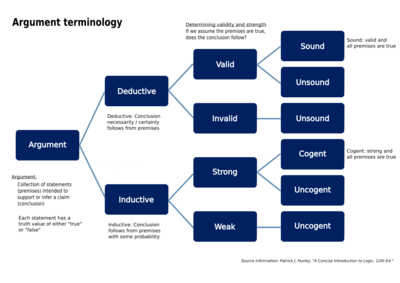Logical reasoning
Topic: Philosophy
 From HandWiki - Reading time: 2 min
From HandWiki - Reading time: 2 min
Two kinds of logical reasoning are often distinguished in addition to formal deduction: induction and abduction. Given a precondition or premise, a conclusion or logical consequence and a rule or material conditional that implies the conclusion given the precondition, one can explain the following.
- Deductive reasoning determines whether the truth of a conclusion can be determined for that rule, based solely on the truth of the premises. Example: "When it rains, things outside get wet. The grass is outside, therefore: when it rains, the grass gets wet." Mathematical logic and philosophical logic are commonly associated with this type of reasoning.
- Inductive reasoning attempts to support a determination of the rule. It hypothesizes a rule after numerous examples are taken to be a conclusion that follows from a precondition in terms of such a rule. Example: "The grass got wet numerous times when it rained, therefore: the grass always gets wet when it rains." This type of reasoning is commonly associated with generalization from empirical evidence. While they may be persuasive, these arguments are not deductively valid: see the problem of induction.
- Abductive reasoning, sometimes called inference to the best explanation, selects a cogent set of preconditions. Given a true conclusion and a rule, it attempts to select some possible premises that, if true also, can support the conclusion, though not uniquely. Example: "When it rains, the grass gets wet. The grass is wet. Therefore, it might have rained." This kind of reasoning can be used to develop a hypothesis, which in turn can be tested by additional reasoning or data. Diagnosticians, detectives, and scientists often use this type of reasoning.
Within the context of a mathematical model, these three kinds of reasoning can be described as follows. The construction/creation of the structure of the model is abduction. Assigning values (or probability distributions) to the parameters of the model is induction. Executing/running the model is deduction.
Other kinds of reasoning beside the three common categories above are:
- Defeasible reasoning
- Paraconsistent reasoning
- Probabilistic reasoning
- Statistical reasoning
See Non-demonstrative reasoning for a comparison of these other kinds of reasoning.
See also
- Analogy
- Argument
- Argumentation theory
- Critical thinking
- Dialogical logic
- Fallacy
- Inference
- Informal logic
- Logic
- Reason
References
- "Applications of Abduction: Knowledge-level modeling", International Journal of Human – Computer Studies: 305–335, 1996
- Flick, Uwe, ed. (2014), "Induction, deduction, abduction", Qualitative Data Analysis, SAGE Publishing
de:Schlussfolgerung nl:Redenering
 |
 KSF
KSF
